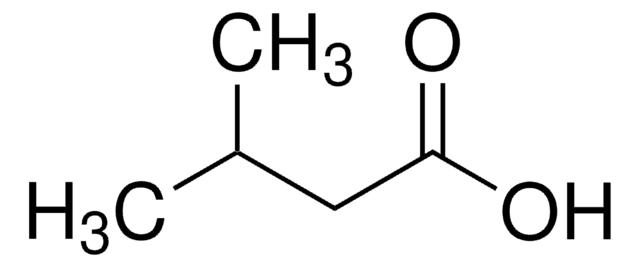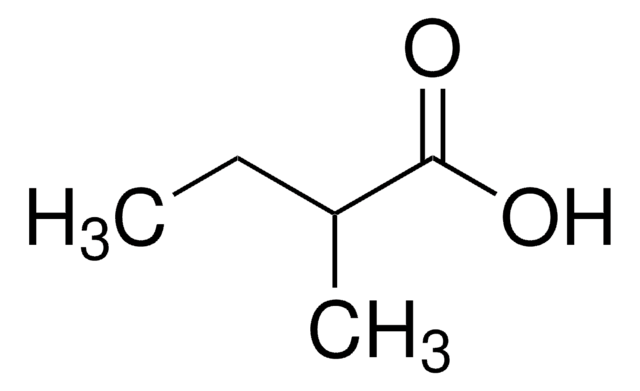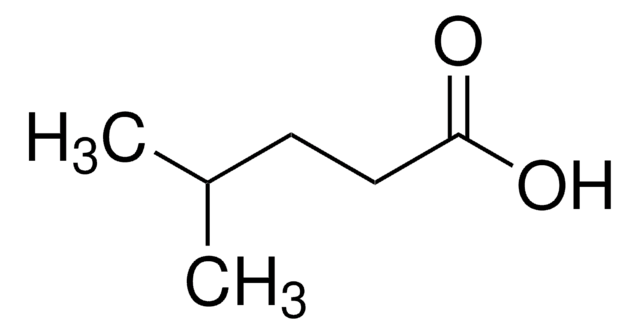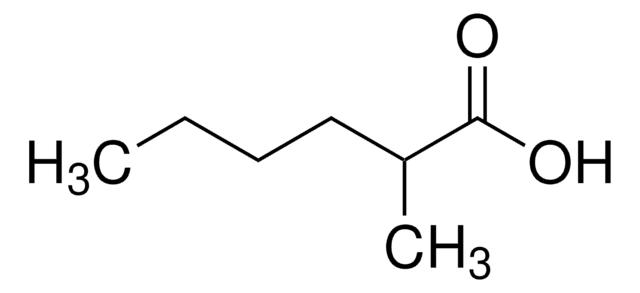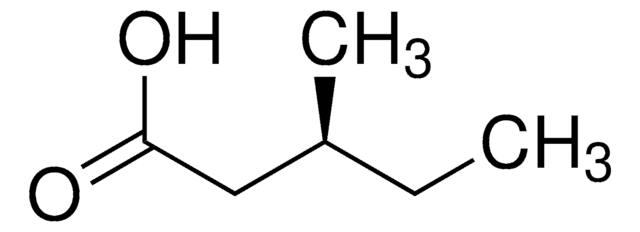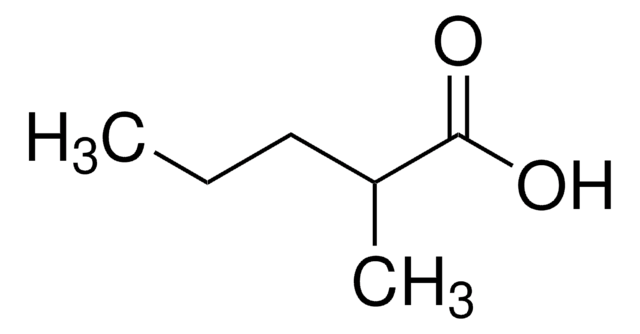All Photos(2)
About This Item
Linear Formula:
C2H5CH(CH3)CO2H
CAS Number:
Molecular Weight:
102.13
EC Number:
MDL number:
UNSPSC Code:
12352100
PubChem Substance ID:
NACRES:
NA.22
Recommended Products
vapor pressure
0.5 mmHg ( 20 °C)
Quality Level
Assay
98%
form
liquid
refractive index
n20/D 1.405 (lit.)
bp
176-177 °C (lit.)
density
0.936 g/mL at 25 °C (lit.)
SMILES string
CCC(C)C(O)=O
InChI
1S/C5H10O2/c1-3-4(2)5(6)7/h4H,3H2,1-2H3,(H,6,7)
InChI key
WLAMNBDJUVNPJU-UHFFFAOYSA-N
Looking for similar products? Visit Product Comparison Guide
Related Categories
General description
2-Methylbutyric acid is a short-chain fatty acid used as a chemical intermediate for plasticizers and lubricants.
Enantioselective esterification of (+/-)-2-methylbutynic acid catalyzed by Chromobacterium viscosum lipase immobilized in microemulsion-based organogels has been investigated.
Enantioselective esterification of (+/-)-2-methylbutynic acid catalyzed by Chromobacterium viscosum lipase immobilized in microemulsion-based organogels has been investigated.
Application
2-Methylbutyric acid was used in the synthesis of 2-methylbutyric anhydride, an acylating agent.
Signal Word
Danger
Hazard Statements
Precautionary Statements
Hazard Classifications
Acute Tox. 4 Dermal - Acute Tox. 4 Oral - Eye Dam. 1 - Met. Corr. 1 - Skin Corr. 1B
Storage Class Code
8A - Combustible corrosive hazardous materials
WGK
WGK 1
Flash Point(F)
170.6 °F - closed cup
Flash Point(C)
77 °C - closed cup
Personal Protective Equipment
dust mask type N95 (US), Eyeshields, Gloves
Choose from one of the most recent versions:
Already Own This Product?
Find documentation for the products that you have recently purchased in the Document Library.
Customers Also Viewed
Enantioselective esterification of 2-methylbutyric acid catalyzed via lipase immobilized in microemulsion-based organogels.
Uemasu I and Hinze WL.
Chirality, 6(8), 649-653 (1994)
Different acylating agents in the synthesis of aromatic ketones on sulfated zirconia.
Deutsch J, et al.
Catalysis Letters, 88(1-2), 9-15 (2003)
Annika Cichy et al.
Current biology : CB, 29(16), 2687-2697 (2019-08-06)
The mammalian main olfactory pathway detects myriad volatile chemicals using >1,000 odorant receptor (OR) genes, which are organized into two phylogenetically distinct classes (class I and class II). An important question is how these evolutionarily conserved classes contribute to odor
Kei M Igarashi et al.
The Journal of neuroscience : the official journal of the Society for Neuroscience, 32(23), 7970-7985 (2012-06-08)
Odor signals are conveyed from the olfactory bulb to the olfactory cortex (OC) by mitral cells (MCs) and tufted cells (TCs). However, whether and how the two types of projection neuron differ in function and axonal connectivity is still poorly
Vineet K Singh et al.
Applied and environmental microbiology, 74(19), 5882-5890 (2008-08-12)
Staphylococcus aureus is a major community and nosocomial pathogen. Its ability to withstand multiple stress conditions and quickly develop resistance to antibiotics complicates the control of staphylococcal infections. Adaptation to lower temperatures is a key for the survival of bacterial
Our team of scientists has experience in all areas of research including Life Science, Material Science, Chemical Synthesis, Chromatography, Analytical and many others.
Contact Technical Service